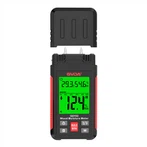What factors should be part of an infrared thermometer selection process?
The following factors should be considered
a) Type
According to on-site requirements, players can hold it (portable) or fix it (online).
Handheld thermometer features: small size, light weight, battery powered, suitable for carrying around, can detect and record temperature at any time, with optical or laser aiming devices, easy to operate, just lightly pull the trigger to measure temperature.
Characteristics of fixed thermometers: They are fixedly installed on industrial sites, can monitor continuously for 24 hours, are connected to computers, and have closed-loop control. By installing protective covers and air and water cooling devices, it can work in harsh environments and high temperature conditions of 315 ℃.
b) Temperature measurement range
The measuring range of the thermometer should meet the requirements for use.
c) Distance coefficient
The distance coefficient D: S is the ratio of the distance between the thermometer and the object being measured to the diameter of the object being measured. The larger this coefficient, the higher the optical resolution of the thermometer. A thermometer with a larger distance coefficient can measure the same object at a greater distance.
Generally speaking, thermometers with high distance coefficients have higher sensitivity and are also more expensive.
d) Minimum target
When the measured object is small, it is necessary to consider whether the small measurement target of the thermometer can meet the usage requirements.
When measuring the surface temperature of luminescent objects, such as aluminum and stainless steel, surface reflections can affect the readings of infrared thermometers. Before reading the temperature, a rubber strip can be placed on the metal surface, and after the temperature is balanced, the temperature in the rubber strip area can be measured. To achieve temperature measurement with an infrared thermometer that can move back and forth from the kitchen to the refrigeration area, it is necessary to wait for a period of time in a new environment to reach temperature equilibrium before measuring. It is best to place the thermometer in a frequently used location. Use an infrared thermometer to read the internal temperature of fluid foods, such as soup or sauce, which must be stirred before measuring the surface temperature. Keep the thermometer away from steam to avoid contaminating the lens and causing incorrect readings.





